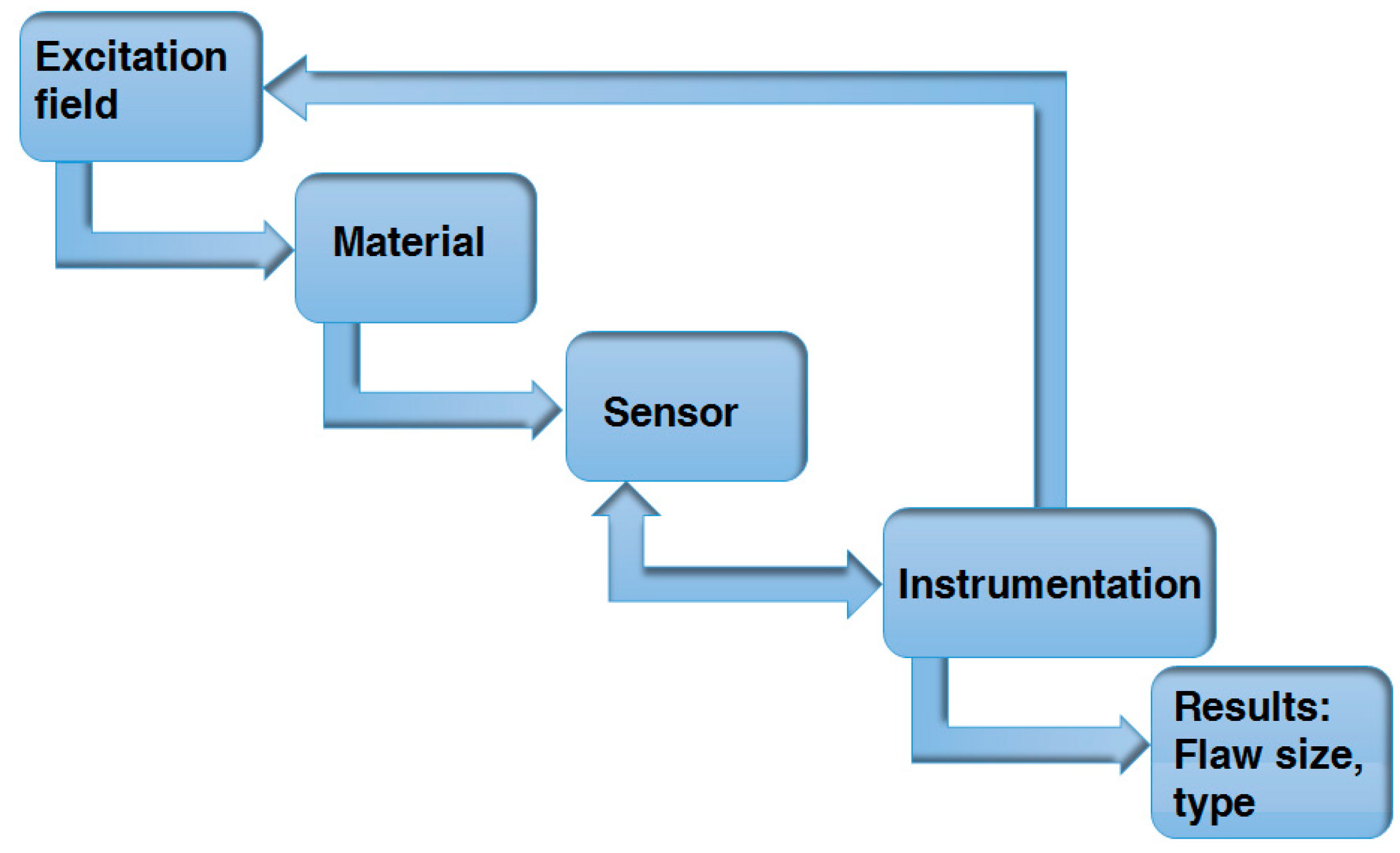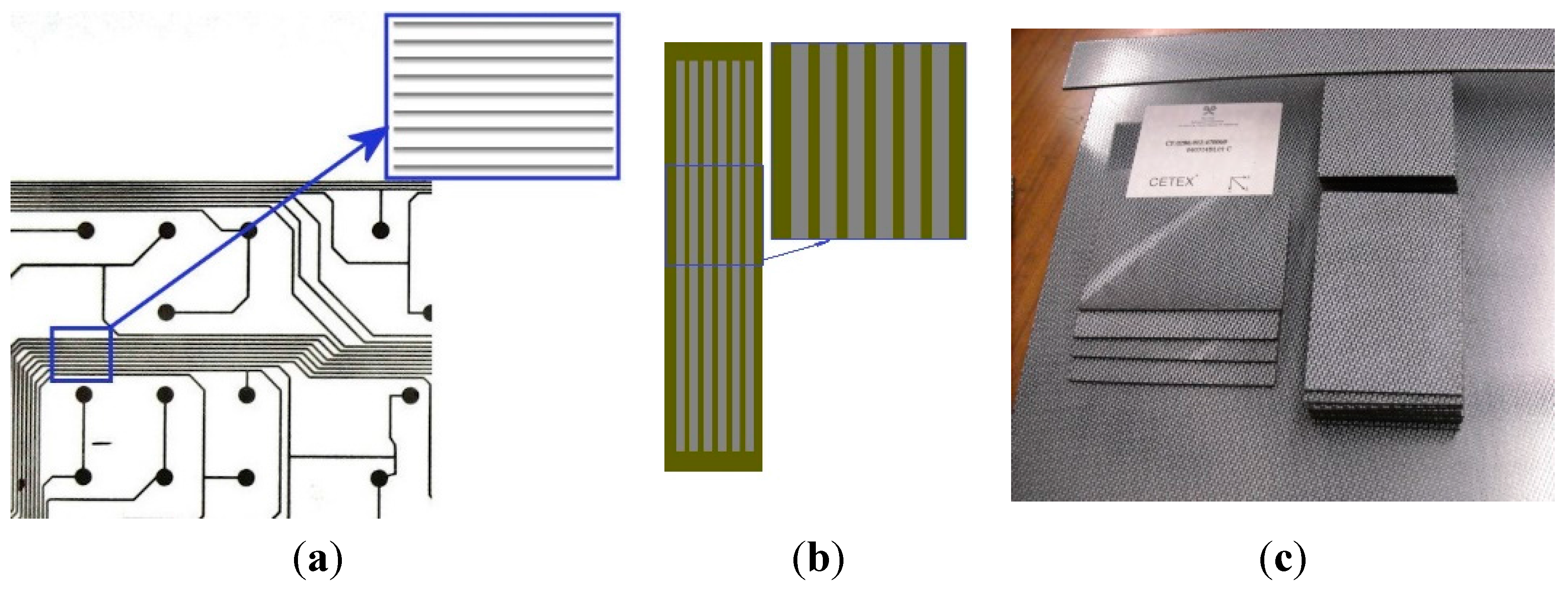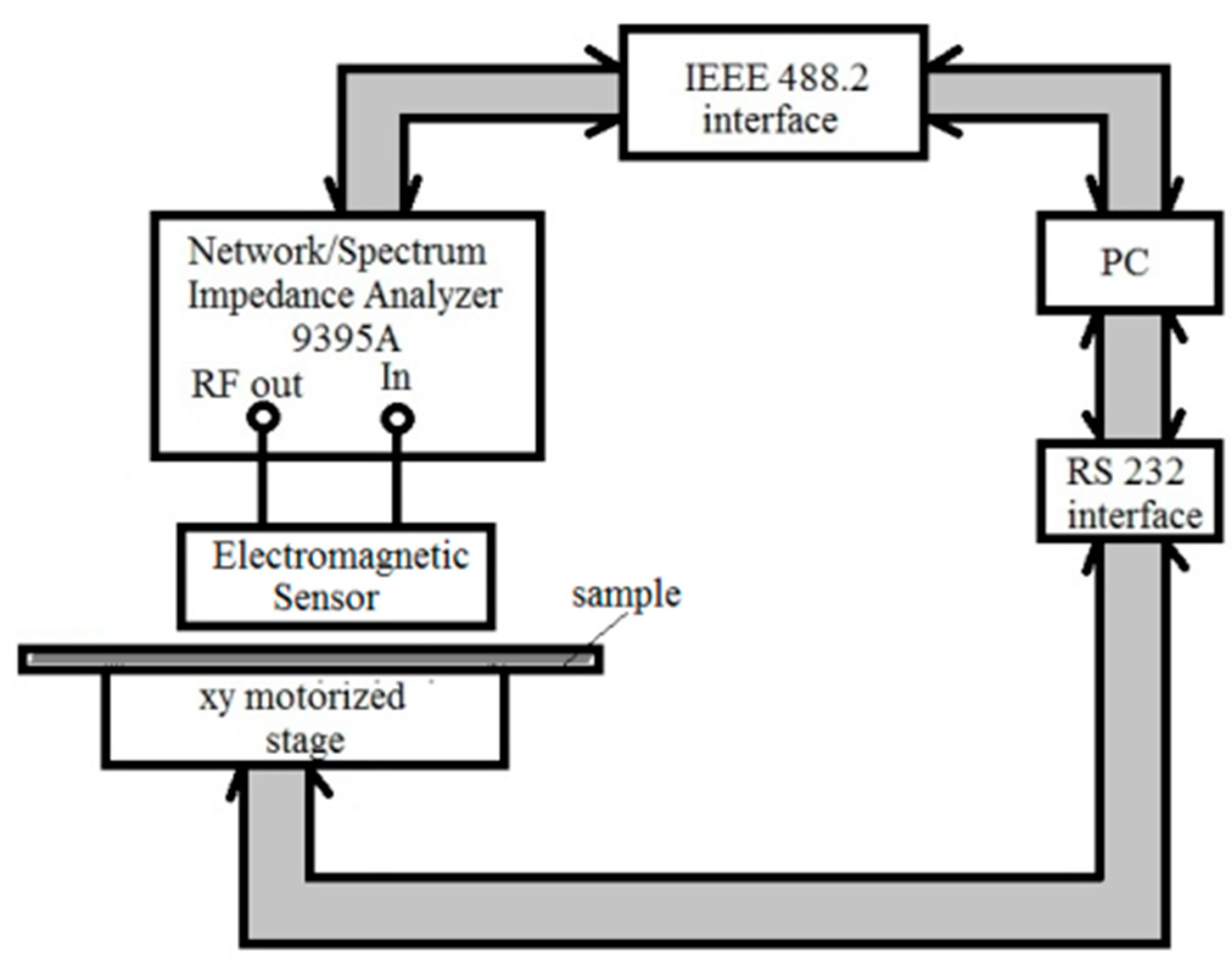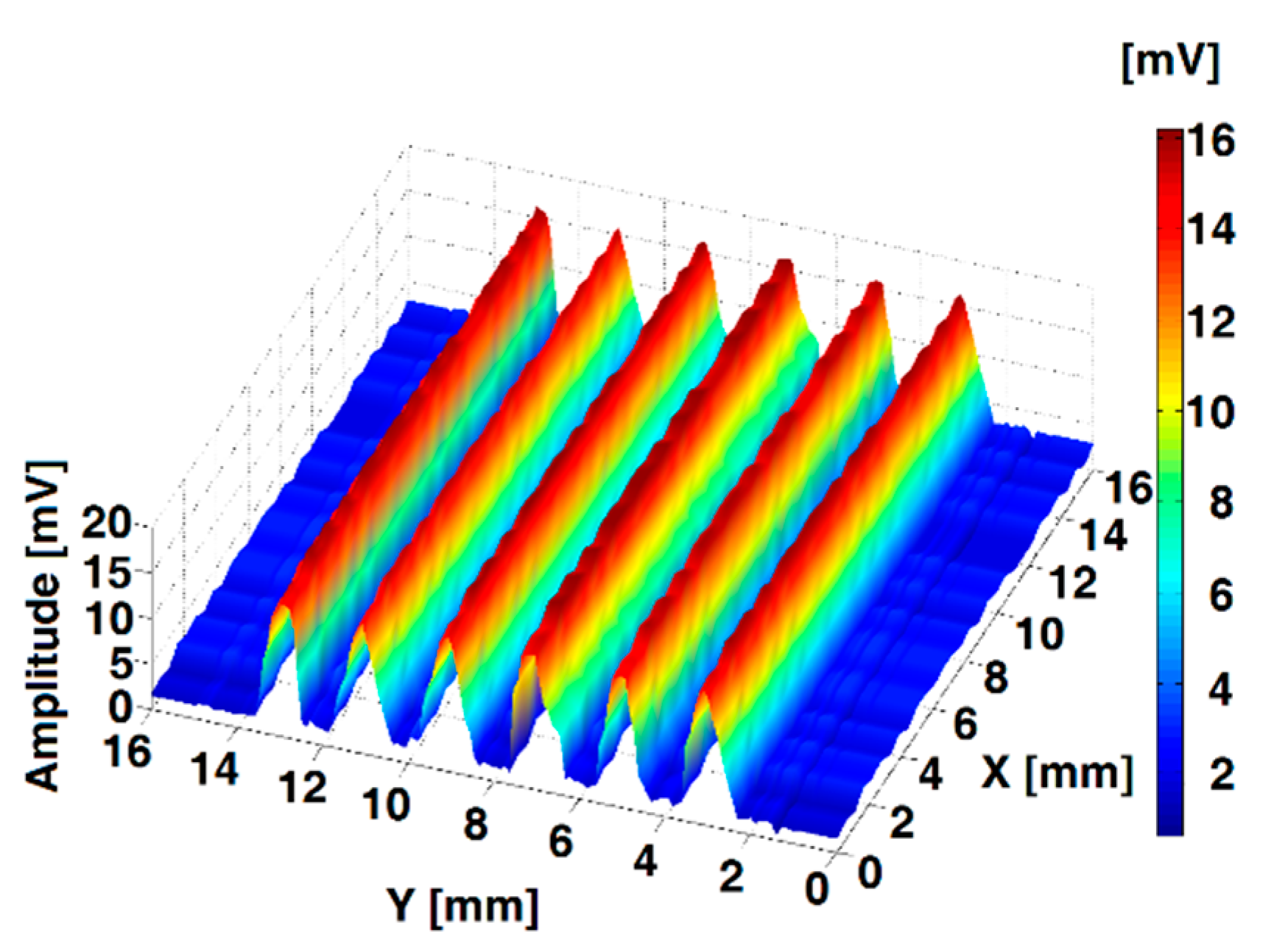Enhancement of Spatial Resolution Using a Metamaterial Sensor in Nondestructive Evaluation †
Abstract
:1. Introduction

2. Metamaterial Sensor for eNDE and Theory
- (a)
- Double positive medium (DSP) when ε > 0 and μ > 0; Only propagating waves;
- (b)
- Single negative medium-electric negative (ENG), when ε < 0 and μ > 0; only evanescent waves;
- (c)
- Double negative medium (DNG) when ε < 0 and μ < 0; propagating waves and evanescent waves;
- (d)
- Single negative medium-magnetic negative (MNG), when ε > 0 and μ < 0; only propagating waves.

3. Studied Samples and Experimental Setup
3.1. Metallic Strip Gratings (MSGs)

3.2. Plates from FRPC Composite Materials

4. Results and Discussion




5. Conclusions
Acknowledgments
Author Contributions
Conflicts of Interest
References
- Bladel, V. Electromagnetic Fields, 2nd ed.; IEEE Press: Piscataway, NJ, USA, 2007. [Google Scholar]
- Theodoulidis, T.P.; Kriezis, E.E. Impedance evaluation of rectangular coils for eddy current testing of planar media. NDT E Int. 2002, 35, 407–414. [Google Scholar] [CrossRef]
- Sablik, M.J.; Burkhardt, G.L.; Kwun, H.; Jiles, D.C. A model for the effect of stress on the low frequency harmonic content of the magnetic induction in ferromagnetic materials. J. Appl. Phys. 1988. [Google Scholar] [CrossRef]
- Harfield, N.; Yoshida, Y.; Bowler, J.R. Low-frequency perturbation theory in eddy-current non-destructive evaluation. J. Appl. Phys. 1996, 80, 4090–4100. [Google Scholar] [CrossRef]
- Theodoulidis, T.P.; Bowler, J.R. Eddy-current interaction of a long coil with a slot in a conductive plate. IEEE Trans. Magn. 2005, 41, 1238–1247. [Google Scholar] [CrossRef]
- Grimberg, R.; Udpa, L.; Savin, A.; Steigmann, R.; Palihovici, V.; Udpa, S.S. 2D eddy current sensor array. NDT E Int. 2006, 39, 264–271. [Google Scholar] [CrossRef]
- Grimberg, R.; Savin, A.; Steigmann, R. Electromagnetic imaging using evanescent waves. NDT E Int. 2012, 46, 70–76. [Google Scholar] [CrossRef]
- Auld, B.A.; Moulder, J.C. Review of advances in quantitative eddy current non-destructive evaluation. J. Nondestruct. Eval. 1999, 18, 3–36. [Google Scholar] [CrossRef]
- Li, Y.; Theodoulidis, T.; Tian, G.Y. Magnetic field based multi-frequency eddy current for multilayered specimen characterization. IEEE Trans. Magn. 2007, 43, 4010–4015. [Google Scholar] [CrossRef]
- Wang, L.; Xie, S.; Chen, Z.; Li, Y.; Wang, X.; Takagi, T. Reconstruction of stress corrosion cracks using signals of pulsed eddy current testing. Nondestruct. Test Eva. 2013, 28, 145–154. [Google Scholar] [CrossRef]
- He, Y.; Pan, M.; Luo, F.; Tian, G. Pulsed eddy current imaging and frequency spectrum analysis for hidden defect nondestructive testing and evaluation. NDT E Int. 2011, 44, 344–352. [Google Scholar] [CrossRef]
- Tai, C.C.; Yang, H.C.; Liang, D.S. Pulsed eddy current for metal surface cracks inspection: Theory and experiment. AIP Conf. Proc. 2002, 21, 388–395. [Google Scholar]
- Wilson, J.W.; Tian, G.Y. Pulsed electromagnetic methods for defect detection and characterization. NDT E Int. 2007, 40, 275–283. [Google Scholar] [CrossRef]
- Mook, G.; Hesse, O.; Uchanin, V. Deep penetrating eddy currents and probes. Mater. Test 2007, 49, 258–264. [Google Scholar] [CrossRef]
- Wong, B.S. Non-Destructive Testing-Theory, Practice and Industrial Applications; Lap-Lambert Publishing GmbH KG: Saarbrücken, Germany, 2014. [Google Scholar]
- Dodd, C.V.; Deeds, W.E. Analytical Solutions to Eddy-Current Probe-Coil Problems. J. Appl. Phys. 1968, 39, 2829–2838. [Google Scholar] [CrossRef]
- Grimberg, R.; Savin, A.; Radu, E.; Mihalache, O. Nondestructive evaluation of the severity of discontinuities in flat conductive materials by an eddy-current transducer with orthogonal coils. IEEE Trans. Magn. 2000, 36, 299–307. [Google Scholar] [CrossRef]
- Bowler, J.R.; Jenkins, S.A.; Sabbagh, L.D.; Sabbagh, H.A. Eddy-current probe impedance due to a volumetric flaw. J. Appl. Phys. 1991, 70, 1107–1114. [Google Scholar] [CrossRef]
- Bihan, Y.L. Study on the transformer equivalent circuit of eddy current nondestructive evaluation. NDT E Int. 2003, 36, 297–302. [Google Scholar] [CrossRef]
- Grbic, A.; Eleftheriades, G.V. Growing evanescent waves in negative-refractive-index transmission-line media. Appl. Phys. Lett. 2003, 82, 1815–1817. [Google Scholar] [CrossRef]
- Petit, R.L.; Botten, L.C. Electromagnetic Theory of Gratings; Springer-Verlag: Berlin, Germany, 1980. [Google Scholar]
- Collin, R.E. Field Theory of Guided Waves; IEEE Press: New York, NY, USA, 1991. [Google Scholar]
- Munk, B. Frequency Selective Surfaces: Theory and Design; John Wiley & Sons, Inc.: New York, NY, USA, 2000. [Google Scholar]
- Balanis, C.A. Antenna Theory: Analysis and Design, 3rd ed.; John Wiley & Sons, Inc.: Hoboken, NJ, USA, 2005. [Google Scholar]
- Brand, G.I. The strip grating as a circular polarizer. Am. J. Phys. 2003, 71, 452–457. [Google Scholar] [CrossRef]
- Arnold, M.D. An efficient solution for scattering by a perfectly conducting strip grating. J. Electromagnet. Wave 2006, 20, 891–900. [Google Scholar] [CrossRef]
- Peterson, A.F.; Ray, S.L.; Mittra, R. Computational Methods for Electromagnetics; IEEE Press: New York, NY, USA, 1998. [Google Scholar]
- Porto, J.A.; Garcia-Vidal, F.J.; Pendry, J.B. Transmission resonances on metallic gratings with very narrow slits. Phys. Rev. Lett. 1999, 83, 2845–2849. [Google Scholar] [CrossRef]
- Kolomenski, A.; Kolomenskii, A.; Noel, J.; Peng, S.; Schuessler, H. Propagation length of surface plasmons in a metal film with roughness. Appl. Opt. 2009, 48, 5683–5691. [Google Scholar] [CrossRef] [PubMed]
- Grimberg, R. Electromagnetic metamaterials. Mater. Sci. Eng. B 2013. [Google Scholar] [CrossRef]
- Grimberg, R.; Savin, A.; Steigmann, R.; Serghiac, B.; Bruma, A. Electromagnetic non-destructive evaluation using metamaterials. Insight 2011, 53, 132–137. [Google Scholar] [CrossRef]
- Pilato, L.A.; Michno, M.J. Advanced Composite; Springer Verlag: Berlin, Germany, 1994. [Google Scholar]
- Morgan, P. Carbon Fibers and Their Composites; CRC Press: Boca Raton, FL, USA, 2005. [Google Scholar]
- Vieille, B.; Taleb, L. About the influence of temperature and matrix ductility on the behavior of carbon woven-ply PPS or epoxy laminates: Notched and unnotched laminates. Compos. Sci. Technol. 2011, 71, 998–1007. [Google Scholar] [CrossRef]
- TenCate Advanced Composites. Available online: http://www.tencate.com/ (accessed on 10 September 2015).
- Kaw, A.K. Mechanics of Composite Materials, 2nd ed.; CRC Press: Boca Raton, FL, USA, 2006. [Google Scholar]
- Standard AS 9100/2009. In Quality Systems-Aerospace-Model for Quality Assurance in Design, Development, Production, Installation and Servicing; SAE: Warrendale, PA, USA, 1999.
- Boller, C.; Meyendorf, N. State-of-the-art in Structural Health monitoring for aeronautics. In Proceedings of the International Symposium on NDT in Aerospace, Fürth/Bavaria, Germany, 3–5 December 2008; pp. 1–8.
- Elmarakbi, A. Advanced Composite Materials for Automotive Applications: Structural Integrity and Crashworthiness. John Wiley & Sons Ltd.: Chichester, West Sussex, UK, 2013. [Google Scholar]
- Boller, C. Next generation structural health monitoring and its integration aircraft design. Int. J. Syst. Sci. 2000, 31, 1333–1349. [Google Scholar] [CrossRef]
- Salvado, R.; Lopes, C.; Szojda, L.; Araújo, P.; Gorski, M.; Velez, F.J.; Krzywon, R. Carbon Fiber Epoxy Composites for Both Strengthening and Health Monitoring of Structures. Sensors 2015, 15, 10753–10770. [Google Scholar] [CrossRef] [PubMed]
- Kordatos, E.Z.; Aggelis, D.G.; Matikas, T.E. Monitoring mechanical damage in structural materials using complimentary NDE techniques based on thermography and acoustic emission. Compos. Part B Eng. 2012, 43, 2676–2686. [Google Scholar] [CrossRef]
- Adden, S.; Pfleiderer, K.; Solodov, I.; Horst, P.; Busse, G. Characterization of stiffness degradation caused by fatigue damage in textile composites using circumferential plate acoustic waves. Compos. Sci. Technol. 2008, 68, 1616–1623. [Google Scholar] [CrossRef]
- He, Y.; Tian, G.Y.; Pan, M.; Chen, D. Impact evaluation in carbon fiber reinforced plastic (CFRP) laminates using eddy current pulsed thermography. Compos. Struct. 2014, 109, 1–7. [Google Scholar] [CrossRef]
- Mian, A.; Han, X.; Islam, S.; Newaz, G. Fatigue damage detection in graphite/epoxy composites using sonic infrared imaging technique. Compos. Sci. Technol. 2004, 64, 657–666. [Google Scholar] [CrossRef]
- Vavouliotis, A.; Paipetis, A.; Kostopoulos, V. On the fatigue life prediction of CFRP laminates using the electrical resistance change method. Compos. Sci. Technol. 2011, 71, 630–642. [Google Scholar] [CrossRef]
- Park, J.M.; Kwon, D.J.; Wang, Z.J.; DeVries, K. Nondestructive sensing evaluation of surface modified single-carbon fiber reinforced epoxy composites by electrical resistivity measurement. Compos. Part B Eng. 2006, 37, 612–626. [Google Scholar] [CrossRef]
- Seon, G.; Makeev, A.; Cline, J.; Shonkwiler, B. Assessing 3D shear stress-strain properties of composites using Digital Image Correlation and finite element analysis based optimization. Compos. Sci. Technol. 2015, 117, 371–378. [Google Scholar]
- Nikishkov, Y.; Airoldi, L.; Makeev, A. Measurement of voids in composites by X-ray Computed Tomography. Compos. Sci. Technol. 2013, 89, 89–97. [Google Scholar] [CrossRef]
- Schilling, P.J.; Karedla, B.R.; Tatiparthi, A.K.; Verges, M.A.; Herrington, P.D. X-ray computed microtomography of internal damage in fiber reinforced polymer matrix composites. Compos. Sci. Technol. 2015, 65, 2071–2078. [Google Scholar] [CrossRef]
- Ren, W.; Liu, J.; Tian, G.Y.; Gao, B.; Cheng, L.; Yang, H. Quantitative non-destructive evaluation method for impact damage using eddy current pulsed thermography. Compos. Part B Eng. 2013, 54, 169–179. [Google Scholar] [CrossRef]
- Hung, Y.Y.; Chen, Y.S.; Ng, S.P.; Liu, L.; Huang, Y.H.; Luk, B.L.; Ip, R.W.L.; Wu, C.M.L.; Chung, P.S. Review and comparison of shearography and active thermography for nondestructive evaluation. Mater. Sci. Eng. R Rep. 2009, 64, 73–112. [Google Scholar] [CrossRef]
- Solodov, I.; Döring, D.; Rheinfurth, M.; Busse, G. New Opportunities in Ultrasonic Characterization of Stiffness Anisotropy in Composite Materials. In Nondestructive Testing of Materials and Structures; Springer: Dordrecht, The Netherlands, 2013; Volume 6, pp. 599–604. [Google Scholar]
- Kolkoori, S.; Hoehne, C.; Prager, J.; Rethmeier, M.; Kreutzbruck, M. Quantitative evaluation of ultrasonic C-scan image in acoustically homogeneous and layered anisotropic materials using three dimensional ray tracing method. Ultrasonics 2014, 54, 551–562. [Google Scholar] [CrossRef] [PubMed]
- Cacciola, M.; Calcagno, S.; Megali, G.; Pellicano, D.; Versaci, M.; Morabito, F.C. Eddy current modeling in composite materials. PIERS Online 2009, 5, 591–595. [Google Scholar]
- Grimberg, R.; Savin, A.; Steigmann, R.; Bruma, A.; Barsanescu, P. Ultrasound and eddy current data fusion for evaluation of carbon-epoxy composite delaminations. Insight 2009, 51, 1–25. [Google Scholar] [CrossRef]
- Lamberti, A.; Chiesura, G.; Luyckx, G.; Degrieck, J.; Kaufmann, M.; Vanlanduit, S. Dynamic Strain Measurements on Automotive and Aeronautic Composite Components by Means of Embedded Fiber Bragg Grating Sensors. Sensors 2015, 15, 27174–27200. [Google Scholar] [CrossRef] [PubMed]
- Takeda, S.; Okabe, Y.; Takeda, N. Delamination detection in CFRP laminates with embedded small-diameter fiber Bragg grating sensors. Compos. Part A 2002, 33, 971–980. [Google Scholar] [CrossRef]
- Savin, A.; Steigmann, R.; Bruma, A.; Šturm, R. An Electromagnetic Sensor with a Metamaterial Lens for Nondestructive Evaluation of Composite Materials. Sensors 2015, 15, 15903–15920. [Google Scholar] [CrossRef] [PubMed]
- Grimberg, R.; Savin, A. Electromagnetic Transducer for Evaluation of Structure and Integrity of the Composite Materials with Polymer Matrix Reinforced with Carbon Fibers. Patent RO126245-A0, 2011. [Google Scholar]
- Pendry, J.; Holden, A.J.; Robbins, D.J.; Stewart, W.J. Magnetism from conductors and enhanced non-linear phenomena. IEEE Trans. Microw Theory Tech. 1999, 47, 47–58. [Google Scholar] [CrossRef]
- Pendry, J.B. Negative Refraction makes a perfect lens. Phys. Rev. Lett. 2000, 85, 3966–3969. [Google Scholar] [CrossRef] [PubMed]
- Cai, W.; Chettiar, U.K.; Kildishev, A.V.; Shalaev, V.M. Optical cloaking with metamaterials. Nat. Photonics 2007, 1, 224–227. [Google Scholar] [CrossRef] [Green Version]
- Smith, D.R.; Pendry, J.B.; Wiltshire, M.C.K. Metamaterials and negative refractive index. Science 2004, 305, 788–792. [Google Scholar] [CrossRef] [PubMed]
- Shelby, R.A.; Smith, D.R.; Schultz, S. Experimental Verification of a Negative Index of Refraction. Science 2001, 6, 77–79. [Google Scholar] [CrossRef] [PubMed]
- Bai, Q.; Liu, C.; Chen, J.; Cheng, C.; Kang, M. Tunable slow light in semiconductor metamaterial in a broad terahertz regime. J. Appl. Phys. 2010. [Google Scholar] [CrossRef]
- Wuttig, M.; Yamada, N. Phase-change materials for rewriteable data storage. Nat. Mater. 2007, 6, 824–832. [Google Scholar] [CrossRef] [PubMed]
- Engheta, N.; Ziolkowski, R.W. Electromagnetic Metamaterials: Physics and Engineering Explorations; John Wiley & Sons, Inc.: New York, NY, USA, 2006. [Google Scholar]
- Zouhdi, S.; Sihvola, A.; Vinogradov, A.P. Metamaterials and Plasmonics: Fundamentals, Modelling, Applications; Springer: New York, NY, USA, 2008. [Google Scholar]
- Veselago, V.G. The electrodynamics of substances with simultaneously negative values of ϵ and μ. Phys. Uspekhi 1968, 10, 509–514. [Google Scholar] [CrossRef]
- Grimberg, R.; Tian, G.Y. High Frequency Electromagnetic Non-destructive Evaluation for High Spatial Resolution using Metamaterial. Proc. R. Soc. A 2012, 468, 3080–3099. [Google Scholar] [CrossRef]
- Born, M.; Wolf, E. Principle of Optics, 5th ed.; Pergamon Press: Oxford, UK, 1975. [Google Scholar]
- Goodman, J.W. Introduction to Fourier Optics, 3rd ed.; Roberts and Company: Englewood, CO, USA, 2005. [Google Scholar]
- Kong, J.A. Electromagnetic Wave Theory; EMW Publishing: Cambridge, MA, USA, 2000. [Google Scholar]
- Shelby, R.A.; Smith, D.R.; Nemat-Nasser, S.C.; Schultz, S. Microwave transmission through a two-dimensional, isotropic, left-handed metamaterial. Appl. Phys. Lett. 2001, 78, 489–491. [Google Scholar] [CrossRef]
- Chen, X.; Grzegorczyk, T.M.; Wu, B.I.; Pacheco, J., Jr.; Kong, J.A. Robust method to retrieve the constitutive effective parameters of metamaterials. Phys. Rev. E 2004. [Google Scholar] [CrossRef] [PubMed]
- Prentice, G.A.; Chen, K.S. Effects of current density on adhesion of copper electrodeposits to polyimide substrates. J. Appl. Electrochem. 1998, 28, 971–977. [Google Scholar] [CrossRef]
- SPI Supplies. Available online: http://www.2spi.com/ (accessed on 10 October 2015).
- Palik, E.D. Handbook of Optical Constants of Solids; Academic Press: London, UK, 1985. [Google Scholar]
- Schlesinger, M. Deposition on Nonconductors, Chapter 15 on Modern Electroplating, 5th ed.; John Wiley & Sons: Hoboken, NJ, USA, 2010; pp. 413–420. [Google Scholar]
- Akkerman, R. Laminate mechanics for balanced woven fabrics. Compos. Part B Eng. 2006, 37, 108–116. [Google Scholar] [CrossRef]
- Standard Test Method for Measuring the Damage Resistance of a Fiber-Reinforced Polymer Matrix Composite to a Drop-Weight Event. ASTM International: West Conshohocken, PA, USA, 2005.
- Menana, H.; Féliachi, M. Electromagnetic characterization of the CFRPs anisotropic conductivity: Modeling and measurements. Eur. Phys. J. Appl. Phys. 2011. [Google Scholar] [CrossRef]
- Ullah, H.; Abdel-Wahab, A.A.; Harland, A.R.; Silberschmidt, V.V. Damage in woven CFRP laminates subjected to low velocity impacts. J. Phys. Conf. Ser. 2012. [Google Scholar] [CrossRef]
- Balanis, C. Advanced Engineering Electromagnetics; John Wiley & Sons: Hoboken, NJ, USA, 1989. [Google Scholar]
- Kunz, K.S.; Luebbers, R.J. The Finite Difference Time Domain Method for Electromagnetics; CRC Press: Boca Raton, FL, USA, 1993. [Google Scholar]
© 2015 by the authors; licensee MDPI, Basel, Switzerland. This article is an open access article distributed under the terms and conditions of the Creative Commons Attribution license (http://creativecommons.org/licenses/by/4.0/).
Share and Cite
Savin, A.; Bruma, A.; Steigmann, R.; Iftimie, N.; Faktorova, D. Enhancement of Spatial Resolution Using a Metamaterial Sensor in Nondestructive Evaluation. Appl. Sci. 2015, 5, 1412-1430. https://doi.org/10.3390/app5041412
Savin A, Bruma A, Steigmann R, Iftimie N, Faktorova D. Enhancement of Spatial Resolution Using a Metamaterial Sensor in Nondestructive Evaluation. Applied Sciences. 2015; 5(4):1412-1430. https://doi.org/10.3390/app5041412
Chicago/Turabian StyleSavin, Adriana, Alina Bruma, Rozina Steigmann, Nicoleta Iftimie, and Dagmar Faktorova. 2015. "Enhancement of Spatial Resolution Using a Metamaterial Sensor in Nondestructive Evaluation" Applied Sciences 5, no. 4: 1412-1430. https://doi.org/10.3390/app5041412





